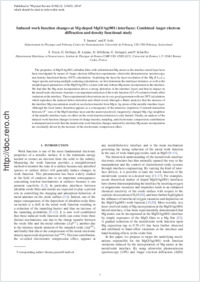Induced work function changes at Mg-doped MgO/Ag(001) interfaces: Combined Auger electron diffraction and density functional study
- Jaouen, Thomas Département de Physique and Fribourg Center for Nanomaterials, Université de Fribourg, Switzerland
- Aebi, Philipp Département de Physique and Fribourg Center for Nanomaterials, Université de Fribourg, Switzerland
- Tricot, S. Département Matériaux et Nanosciences, Institut de Physique de Rennes UMR UR1-CNRS 6251, Université de Rennes, France
- Delhaye, G. Département Matériaux et Nanosciences, Institut de Physique de Rennes UMR UR1-CNRS 6251, Université de Rennes, France
- Lépine, B. Département Matériaux et Nanosciences, Institut de Physique de Rennes UMR UR1-CNRS 6251, Université de Rennes, France
- Sébilleau, D. Département Matériaux et Nanosciences, Institut de Physique de Rennes UMR UR1-CNRS 6251, Université de Rennes, France
- Jézéquel, G. Département Matériaux et Nanosciences, Institut de Physique de Rennes UMR UR1-CNRS 6251, Université de Rennes, France
- Schieffer, Philippe Département Matériaux et Nanosciences, Institut de Physique de Rennes UMR UR1-CNRS 6251, Université de Rennes, France
-
22.09.2014
Published in:
- Physical Review B. - 2014, vol. 90, no. 12, p. 125433
English
The properties of MgO/Ag(001) ultrathin films with substitutional Mg atoms in the interface metal layer have been investigated by means of Auger electron diffraction experiments, ultraviolet photoemission spectroscopy, and density functional theory (DFT) calculations. Exploiting the layer-by-layer resolution of the MgKL23L23 Auger spectra and using multiple scattering calculations, we first determine the interlayer distances as well as the morphological parameters of the MgO/Ag(001) system with and without Mg atoms incorporated at the interface. We find that the Mg atom incorporation drives a strong distortion of the interface layers and that its impact on the metal/oxide electronic structure is an important reduction of the work function (0.5 eV) related to band-offset variations at the interface. These experimental observations are in very good agreement with our DFT calculations which reproduce the induced lattice distortion and which reveal (through a Bader analysis) that the increase of the interface Mg concentration results in an electron transfer from Mg to Ag atoms of the metallic interface layer. Although the local lattice distortion appears as a consequence of the attractive (repulsive) Coulomb interaction between O2− ions of the MgO interface layer and the nearest positively (negatively) charged Mg (Ag) neighbors of the metallic interface layer, its effect on the work function reduction is only limited. Finally, an analysis of the induced work function changes in terms of charge transfer, rumpling, and electrostatic compression contributions is attempted and reveals that the metal/oxide work function changes induced by interface Mg atoms incorporation are essentially driven by the increase of the electrostatic compression effect.
- Faculty
- Faculté des sciences et de médecine
- Department
- Département de Physique
- Language
-
- English
- Classification
- Physics
- License
- License undefined
- Identifiers
-
- RERO DOC 233228
- DOI 10.1103/PhysRevB.90.125433
- Persistent URL
- https://folia.unifr.ch/unifr/documents/303998
Statistics
Document views: 77
File downloads:
- aeb_iwf.pdf: 98
